
Candida Martinelli's Italophile Site

Main
Page This family-friendly site celebrates Italian culture for the enjoyment of children and
adults. Site-Overview
These are two replicas of Renaissance majolica designs (1400) make in
the 1700s, now housed at the French castle Usse. Two examples of Majolica with deep blues, one of the oldest
colors, originally made with cobalt stone from the Middle East, ground
into powder. I love majolica!
Since the first moment I set eyes on it, I've made pilgrimages to
majolica factories and annoyed countless potters and painters by
watching them work and asking silly questions. The process of making majolica consists of: This type of ware was produced in the ancient Middle East by the
Babylonians, and the method has remained continuously in use. Each
majolica-making region of Italy is rightfully proud of their over 500
year heritage. I found myself unknowingly offending some Italians
by professing a preference for one region's pottery over
another's. So be careful what you say to whom when talking about
majolica in Italy! It can be an emotive subject. Just an extra note. The prices have sky-rocketed in recent
years. Partly because of increased demand from abroad, and
increased perceived value, and higher labor costs. But if you are in Italy, you can save much money buying directly
from the factories. Pack the small items carefully, and you
can bring them home yourself in your luggage. Here's a link
to the history of majolica that covers the Etruscans to present day. My favorite site for majolica dreaming and learning is Artistica.
It's an on-line majolica warehouse. Even if you don't want to buy anything, the site offers an
illustrated guide to all styles of pottery made in Italy today!
Click here or on the putto, the
cherub, to the right, to visit their site.
(You might want to switch off your computer's speakers for a while. When you
go to the site, you'll hear what I mean!) Artistica Majolica Products from Amazon.com And The National
Gallery of Art has a whole section dedicated to the subject of
majolica.
Luckily for us, it is also on-line. To view their Italian
Renaissance Ceramics Collection, click here
or on the treasure hunter, an
earlier version of a collector, to the right. There's a lovely description of the history of Italian majolica on
a site dedicated to teaching the art of illumination. Their text
is accompanied by beautiful examples of classic and modern majolica.
Click here,
or on the woman working her clay (no, it's not dough; I say it's
clay!), to the right, to link to the history of Italian majolica page. Click on the logo below to visit the website of a majolica shop on
Nantucket Island in the U.S. state of Massachusetts. They have
a wonderful 'Making Majolica' page in the 'About Majolica'
section that is full of pictures of the whole process.
The Life in
Italy site offers courses in making and painting majolica in Deruta,
Italy. Deruta is one of the most famous majolica centers in
Italy, famous for the Raffaelesque design you can see in some of the
images to the left. To go directly to the information about Deruta, click here.
To visit the main page of the Life in Italy site, click on the logo
below. The site offers unique products and services like fresco
painting, personal shoppers in Italy, Italian silverware, truffle
products, and mosaics. There are many
collectors of majolica who search out designs painted by famous artists
like Leonardo da Vinci and Michelangelo. If you are in Florence,
you can visit the family home of Michelangelo, Casa Buonarotti,
which is today a museum, and see several platters (tondi) that he
painted for local wealthy families.
The same bright colors on the tondi
can be found in the newly cleaned ceiling of the Vatican's Sistine
Chapel. The Casa has a very nice site in English showing all the
rooms and the major works on display.
Click here
or on Bevis, the last
person you'd expect to find at the museum (at least I hope so, for your
sake), to visit their site. (The link doesn't always work, but
when it does, it's a very nice site.) The greatest Italian artist using majolica was Della Robbia.
He crafted delicate religious designs that stand the test of time.
Here is a design from a Renaissance chapel in France, from the Usse
castle estate.
His designs were so popular, that his descendents lived by making
reproductions of his work for generations.
This
'Nativity' is also by Giovanni Della Robbia. It is in The
Hermitage museum in St. Petersburg.
Majolica is not
only made in Italy. The name comes from Mallorca, an early
transport site for pottery from Spain to Italy. In France it is
called Faience after the Italian town Faenza. In Holland it
is called Delftware, or Delfts-Blau. The English call it
by it's Italian and French names, and have a very long history of making
their own majolica. They are also avid collectors of old examples
of English majolica. On one episode of the BBC's Antiques
Roadshow, I saw the appraiser put a price of 60,000 British Pounds
on a majolica commemorative drinking cup. The cup had been made to
commemorate the ascension to the thrown of George the Third, in 1760,
and the woman who owned it admitted that it usually sat on their
fireplace mantle holding pencils and pens.
You can see what books are available at Amazon.com about
Majolica,
what people's comments on the books
are, and what they cost. My list of Majolica books
at Amazon.com To look up more specific books, you can use this
Amazon.com Search tool. Just enter 'Books' in the
'Search' field, and, for example, 'majolica history' in the 'Keywords' field. Then click
on the 'Go' button to see the list.

Majolica,
Italian Glazed Pottery, History...
![]()
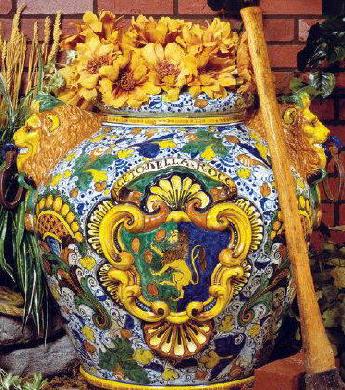
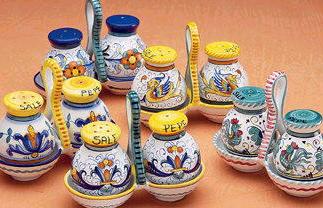
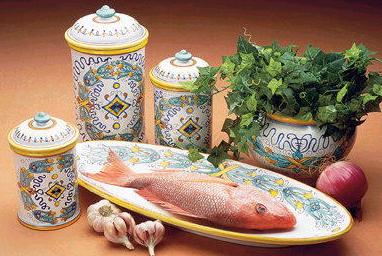
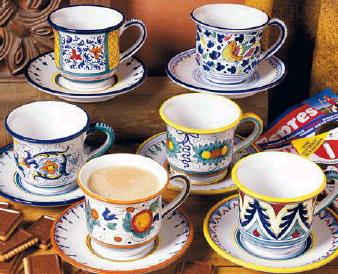
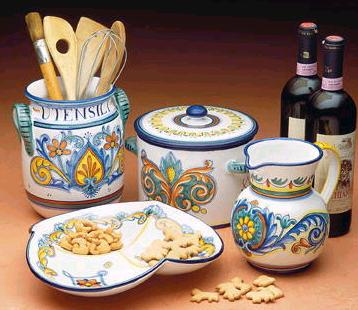


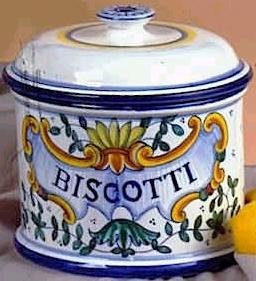
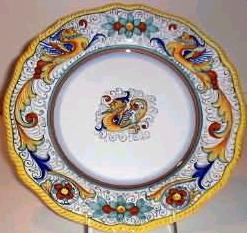


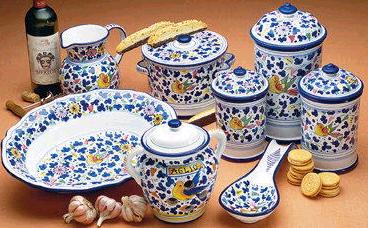
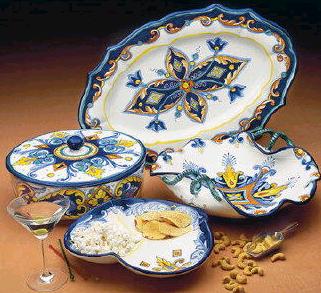
Introduction
History of Majolica
Making Majolica
Michelangelo
and Majolica
Giovanni Della Robbia


Majolica
by any other name is just as beautiful
Books About Majolica


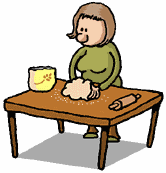
![]()
Some
Italian Majolica Available via Amazon.com